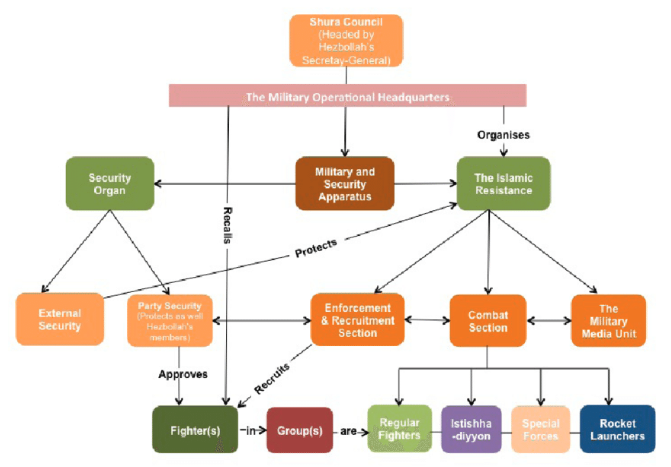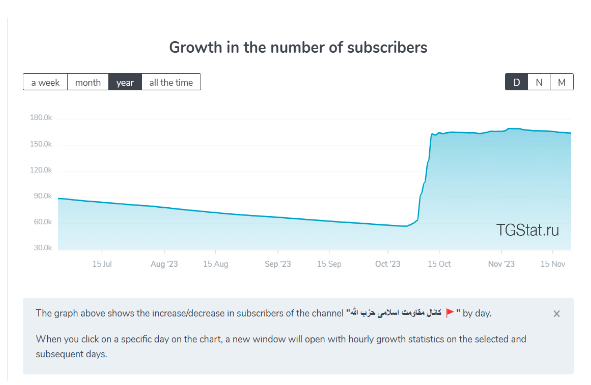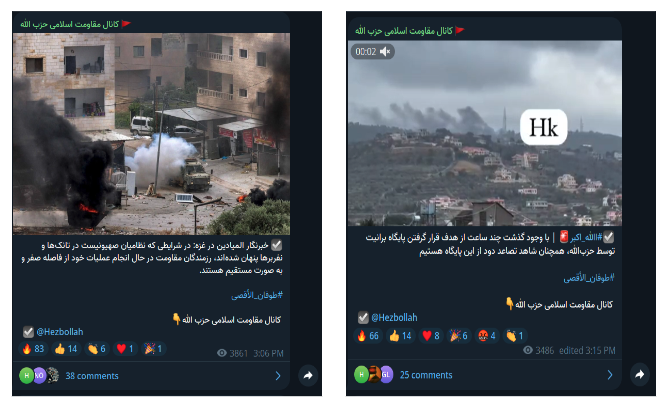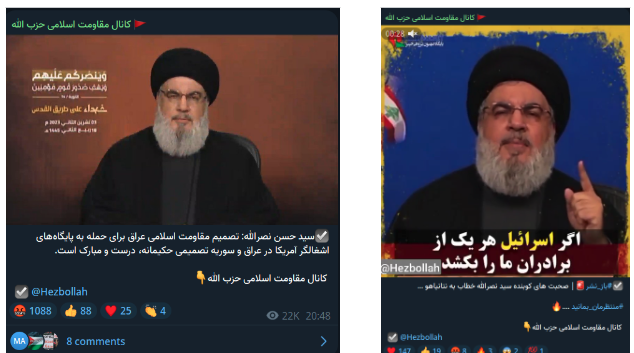Introduction
Since 7 October, war has been raging in the Gaza Strip, as Hamas and Israel fight each other in every frontier, including social media. While most media and academic coverage of the conflict has focused on both these sides, attention should also be paid to certain actors trying to meddle in the conflict, particularly the Iranian-backed militia, Hezbollah. Hezbollah is a Lebanese-based Shiite political party and militant group with an extensive military, political, and economic network in the country, and is classified as a terrorist organisation in the US. Historically, Hezbollah has been one of the key players in the Middle East – its main goal is to kick the US and its allies from the region and form a Shiite Islamic state. This correlates with its current policy towards Israel, which is Hezbollah’s main adversary in the region. Hezbollah’s primary interest in the war is to undermine Israel’s ability to push Hamas out of Gaza by any means possible.
In the context of the current conflict, Hezbollah is seizing the opportunity to aggravate and intervene in the conflict, particularly via its Military Media Unit on Telegram. Aside from Telegram, Hezbollah has used several social media platforms, but in recent years, Hezbollah has had difficulties in projecting its narratives due to social bans from those platforms. Now, Hezbollah’s main social media platform is Telegram, where its Military Media Unit projects its own narratives throughout cyberspace.
This Insight aims to unfold the motive of Hezbollah through its Military Media Unit in the ongoing Israel-Palestine war. It explores how Hezbollah propagates its narrative through social media, especially Telegram. In particular, the Islamic Resistance, the military wing of Hezbollah, pursues a harsh stance on the Israeli invasion of Gaza. This stance consequently becomes a part of the information war in the ongoing conflict.
The Islamic Resistance
The emergence of this military wing cannot be separated from Israel’s invasion of Lebanon in 1982. It first served as the militant group of the Shiite population with the primary aim of resisting Israeli presence. Since then, Hezbollah has gained a large amount of support and exposure, mainly from Iran and Syria. Its development, particularly the military wing, was due to the help of the Iranian Revolutionary Guard training its fighters. According to its first political document in 1985, Hezbollah stated that a military organ must not be separated from the rest of its body. As such, in Hamzeh’s illustration (Fig. 1), the Islamic Resistance is linked directly to Hezbollah’s Secretary General through the Military Operational Headquarters. Understanding this power relation is crucial as we delve into Hezbollah’s efforts to strengthen its presence politically and militarily using its media unit.
Military Media Unit
Controlling information flow is just as crucial as frontline efforts. As a result, in 1984, the Islamic Resistance established the Military Media Unit, which was tasked with waging information warfare against Israel and publicising the actions of its ‘Islamic Resistance’ symbol. Their media infrastructure is highly developed and as powerful and influential as its combat counterpart in effectively disseminating the party’s image, identity, and strategies to the wider public. As its name implies, this unit received military and ideological training from the regular combat unit and artistic training. Their responsibilities include documenting military operations against Israel, recording combatants’ testimonies, and producing video songs, speeches, and propaganda materials. The outputs are then distributed to Hezbollah-affiliated media sources, including its Telegram channel.
The formation of this unit by the Islamic Resistance and Hezbollah signifies their understanding of the importance of controlling the media to advance their cause. Their propaganda shapes public opinion, instilling fear and unsettling regional stability. In the current stage of the war, Hezbollah could only engage in skirmishes with Israeli troops bordering Lebanon. In doing so, they emphasise spreading messages and narratives to embolden their supporters and threaten their enemies. As shown in Fig. 1, The Military Media Unit is an important apparatus; the unit is positioned under The Islamic Resistance, thus establishing a direct link with the highest rank in the organisation.

Fig. 1: Position of The Military Media Unit within Hezbollah’s organisational structure. It receives orders directly from the Islamic Resistance and cooperates with other adjacent apparatus when needed.
Nexus of Telegram, Military Media Unit, and the Current War
In the past years, Hezbollah faced numerous challenges in cyberspace, prominently when Twitter suspended the accounts of Hezbollah TV station Al Manar back in 2019. Facebook also restricted keywords that linked directly to Hezbollah, including its leader’s name, in early 2023. This makes Telegram, a messaging app and social network, the favoured communication platform for various organisations, including Hezbollah, due to its limited content moderation policies and ability to bypass government prohibitions. It has significantly contributed to the ongoing war by serving as a venue outside the mainstream media to disseminate real-time footage, ranging from providing basic information about the current situation to depicting highly graphic violence in real time. Telegram is increasingly emerging as the primary source of information from various militia factions such as ISIS and Hamas. The emergence of such a phenomenon can be traced back to 2015, when ISIS used the platform to disseminate propaganda that encouraged their audience to carry attacks throughout the world. Nowadays, we see a similar pattern in the case of Hezbollah’s Military Media Unit. This is evidenced by the chart below (Fig. 2), which illustrates the increase in subscribers to Hezbollah’s official channel.

Fig. 2: Growth in the number of subscribers (TGStat.ru)
Before the conflict, the channel was experiencing a period of steady decline; however, this situation witnessed a reversal following the escalation of conflict in Gaza. The number is rising due to the continuous production of new narratives and propaganda by the Military Media Unit. These new narratives and propaganda include how Hezbollah is defending Hamas for its attack against Israel and voicing its absolute support for the Palestinian cause. Hezbollah is trying to capitalise on the situation for its own interest in pumping up its declining popularity. These narratives align with Hezbollah’s objectives and goals and Lebanese public opinion. Given the significant increase in users, it may be reasonably inferred that Telegram is playing a role in enabling the transmission of information from Hezbollah’s Military Media Unit. The relationship between Telegram and the Military Media Unit can be analysed further by identifying the kinds of messages broadcast by the channel.
Footage of War

Figs. 3-4: Footage of the ongoing war in Gaza (left) and Israeli-Lebanese border (right).
One of the main features of the channel is the consistent flow of real-time footage of the war in Gaza and clashes along the Israel-Lebanon border. As shown in Figs. 4 and 5, the channel puts forward its own narratives to complement the footage and further Hezbollah’s agenda. Fig. 3 shows how the IDF soldiers, labelled as Zionists, are hiding in their tanks and personal carriers to defend themselves against Hamas fighters in Gaza. Fig. 4 shows the aftermath of Hezbollah’s attack on Branit Military Base in Northern Israel, highlighting their success in eliminating an Israeli military base. Regardless of the authenticity of the information shared, Hezbollah has managed to disseminate its version of the current situation enough to expand its influence in the conflict. Hezbollah’s channel is gaining momentum as an alternative source of information throughout the course of the conflict. As depicted in Fig. 2, the number of subscribers correlates as the war progresses, with its channel experiencing a spike in subscribers following Hamas’ strike on 7 October. This is prevalent among Hezbollah’s own supporters and some Palestinians who support and appreciate Hezbollah’s effort against Israel.
This pattern is not unique to Hezbollah; we can observe similar patterns in previous conflicts such as the Russo-Ukrainian War. In that context, pro-Russia and pro-Ukraine channels disseminated their own narratives for their respective audiences, portraying their own version of the situation on the ground using real-time footage of the war.
The Speech of Hasan Nasrallah

Figs. 5-6: Messages posted on Telegram about Hasan Nasrallah’s speech.
The speech Hezbollah’s Secretary General Hassan Nasrallah delivered on 3 November was a critical component of the Military Media Unit’s campaign. The unit emphasises producing and spreading Nasrallah’s speech to maintain his influence on the public, thus boosting the morale of his followers. As he addressed his adherents, Nasrallah commented on the ongoing conflict and the future course of action for Hezbollah. One of the main aspects of his speech was his endorsement of Hamas’ 7 October attack on Israel, which killed around 1,200 Jewish people, claiming that the murders were a consequence of the Israeli occupation of Palestine.
He urged his followers to support Hamas’ cause and make preparations to launch a similar attack on Israel in the name of Hezbollah. While many anticipated that Nasrallah would formally proclaim an escalation, he however stated that Hezbollah had only entered the conflict a day after Hamas launched its assault. His speech was widely disseminated on the Islamic Resistance’s Telegram channel, garnering considerable support from Hezbollah sympathisers. These speech-related posts usually have 10-20k views, estimated from observing each post on the channel.
Messages of Militaristic Propaganda

Fig. 7-8: Video (left) and image (right) showing propaganda with militaristic type.
Fig. 7 is a piece of military propaganda produced by Hezbollah depicting troops positioned in front of flags representing Lebanon, Hezbollah, and Palestine. The caption was translated from Arabic into Hebrew, highlighting their intent to engage in combat and impose pressure on Israel. Following its sharing on Telegram, the video received over 40k views. Fig. 8 depicts a fighter coupled with the caption that translates to Hezbollah’s intimidation to eradicate its opponents, including Israel. These two examples showed that spreading messages on Telegram effectively gains attention without the risk of getting banned or removed from mainstream media platforms.
Conclusion
Hezbollah has emerged as a prominent player in the ongoing conflict between Israel and Hamas. Hezbollah’s Military Media Unit disseminates its own strategic narratives and propaganda via its channel on Telegram. The current trajectory of the conflict shows that Hezbollah is still engaging in information warfare with Israel and will likely continue to do so as long as the IDF persists with their ground invasion of Gaza. However, Hezbollah’s channel will likely see a decline again as a result of Hezbollah’s hesitation to directly involve itself in the Israel-Hamas conflict. Nevertheless, Hezbollah managed to gain some additional support due to its adeptness at projecting its narratives in supporting Hamas’ attack on Israel.
The latest information shows that the Islamic Resistance channel cannot be found and accessed through the Telegram application downloaded from the Google Play Store. Nevertheless, the channel can still be found easily through the desktop version of Telegram. This is related to Telegram’s actions that ultimately blocked Hamas channels because they had to follow Google’s app store guidelines. However, it is crucial to implement this measure across all versions of the Telegram app to effectively eradicate disinformation and messages promoting terrorism. To hinder the dissemination of information by Hezbollah, its opponents must adopt measures to moderate and restrict their capacity to communicate their views, particularly on the Telegram platform.
Jonathan Suseno Sarwono is an undergraduate International Relations student at Universitas Diponegoro. Currently, his study interest is focused on security, online extremism, and cybercrime.
Muhammad Fatih Khudri is an undergraduate International Relations student at Universitas Diponegoro. Currently, his study interest is focused on geopolitics, security, and history.
